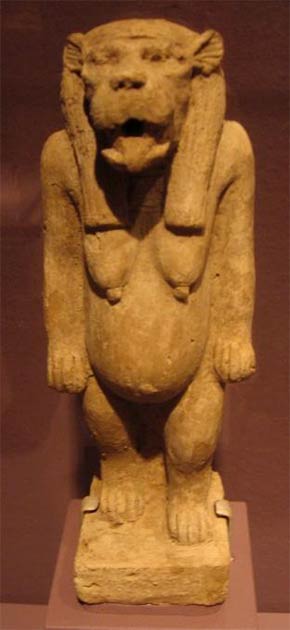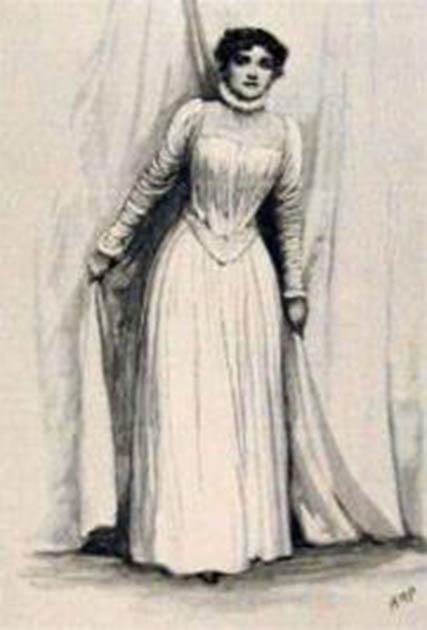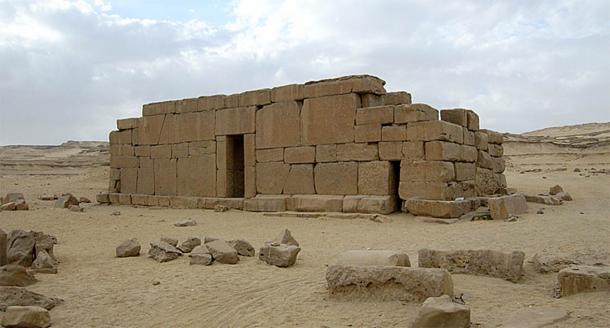In 2017 cinema audiences were treated to the latest reboot of the classic movie franchise surrounding the resurrection of an ancient Egypt mummy. Titled, inevitably, The Mummy, and starring Tom Cruise, it was an action-packed thriller featuring an Egyptian princess named Ahmanet. She, however, was just the latest incarnation of a fictional character that appears for the first time in a novel written by celebrated Irish writer Bram Stoker (1847-1912). Entitled The Jewel of the Seven Stars, it tells the story of how an ancient Egyptian queen and sorceress named Tera is able to live again in the modern world. When first published in 1903, the book’s ending was deemed so shocking that the publisher asked for it to be replaced in all subsequent editions. Compelling new evidence today suggests that Stoker’s Queen Tera was inspired by Egypt’s first female ruler, who lived around 1800 BC. Her name was Sobekneferu (also written Neferusobek), and although she ruled for just four years at the end of the Twelfth Dynasty the repercussions of her reign were long lasting and continue to be felt today.

Bram Stoker, the author of the novels ‘Dracula’ (1897) and ‘The Jewel of the Seven Stars’ (1903), among many others. Credit: public domain
Egypt’s Twelfth Dynasty (circa 1991-1802 BC) came towards the end of the country’s Middle Kingdom. Four of its eight kings all bore the name Amenemhat, honoring the god Amun. This included Amenemhat III, Sobekneferu’s father, who reigned circa 1860-1814 BC. He was followed by his son Amenemhat IV, Sobeknefereu’s brother. His reign, which lasted nine years, circa 1815-1806 BC, was followed by that of his sister, Sobekneferu ( Manetho, 34.7 ). Inscriptions bearing the name both of Amenemhat III and of Sobekneferu suggest co-regency, while some scholars have proposed that following her father’s death she entered into an incestuous marriage with her brother (Gillam, s.v. “Sobeknefru,” in Erskine et al, 2013 ). Beyond this everything is unclear. All we do know is that, as her name suggests, she was devoted to the crocodile god Sobek, and that both she and Sobek continued to be venerated well into the incoming Thirteenth Dynasty ( Massey, 1881, ii, 402-3 & Grant, 1975, 59 ).

Bust of Sobekneferu on display in the Louvre, Paris. Credit: Wiki Commons Agreement, 2020.
The Real Queen Tera
So how do we know that Sobekneferu was the inspiration behind Stoker’s Queen Tera in The Jewel of the Seven Stars ? The story tells us she lived “forty centuries” ago and was the only daughter of King Antef, who reigned during the Eleventh Dynasty. Now, there was indeed a king named Antef who ruled during the Eleventh Dynasty, circa 2130-1991 BC. In fact, there were four kings all named Antef who reigned during this dynasty. Yet none of them had a notable daughter fitting Queen Tera’s description.
Bringing us closer to an identification of Stoker’s Queen Tera is his statement that in her tomb, “Prominence was given to the fact that she, though a Queen, claimed all the privileges of kingship and masculinity. In one place she was pictured in man’s dress, and wearing the White and Red Crowns . In the following picture she was in female dress, but still wearing the Crowns of Upper and Lower Egypt.” This is a major clue to who Queen Tera might have been, for Stoker would have been aware that Sobekneferu was the first royal female to wear the twin crowns of Upper of Lower Egypt. This was three centuries earlier than the reign of Queen Hatshepsut, who is another candidate for the true identity of Stoker’s Queen Tera (see, for instance, the introduction to Penguin New York’s 2008 edition of The Jewel of the Seven Stars by Kate Hebblethwaite). She, however, ruled Egypt as much as 500 years after the intimated “forty centuries” ago that Stoker tells us Queen Tera lived on earth.
Moreover, there is a link too between Sobekneferu and a king named Antef, her father’s name in Stoker’s novel. A king list known as the Royal Tablet of Karnak, published before Stoker wrote his book, shows a king named Antef ruling immediately after Sobekneferu, something that led some commentators of the time to suspect the two were related and perhaps even married ( Macnaughton, 1932, 157 ). Was this Antef the inspiration behind Queen Tera’s father, who in the 1980 film adaption of Stoker’s book (see below) was actually married to his daughter?

The cover of Bram Stoker’s first edition of The Jewel of the Seven Stars published in 1903. Credit: public domain.
Bram Stoker tells us that Queen Tera was obsessed with the stars of the northern night sky, in particular the seven stars of Ursa Major , and there is every indication that Sobekneferu was interested in this same set of stars through her veneration of the crocodile god Sobek. In ancient Egyptian astronomy the crocodile was shown climbing on the back of a female hippopotamus, or as part of a hippo-croc hybrid. This combined sky figure has been identified with the stars of Draco, the celestial dragon of Greek and Arabic sky lore ( Lull and Belmonte, 2009 ), one of the key constellations of the northern night sky. Both the crocodile and hippo have also been identified with the stars of Ursa Major and Ursa Minor ( Berio, 2014 ), which are themselves extremely close to Draco.
The Deep Bosomed One
The connection here with Sobekneferu comes from the fact that a limestone block fragment found at Hawara links her with the obscure goddess Dhdh.t (Dehdehet) ( Uphill, 2010 ), whose name means “to hang down low.” This, seemingly, is a reference to drooping breasts, implying she is the “Deep-bosomed One.” (pers. comm. with the late Terence DuQuesne). This is undoubtedly a title of Egypt’s principal hippopotamus goddess Tawaret, who was Sobek’s wife. Tawaret presided over women during childbirth and pregnancy and is shown in art with long drooping breasts. What is more, she was a patron, like Sobek, of Egypt’s Faiyum Oasis, the royal seat of Sobekneferu. She was also the concubine of Seth, the god of desert lands and foreigners, who, like Sobek, often took the form of a crocodile.

Head of the crocodile god from the site of the Labyrinth at Hawara. It dates to the reign of Amenemhat III. Credit: Wiki Commons Agreement, 2020.

The hippopotamus goddess Tawaret. Was she the mysterious goddess revered by Sobekneferu? Credit: Wiki Commons Agreement, 2020.
Goddess of the Seven Stars
Thus, through her connections with sky figures such as the crocodile and hippopotamus, both of which are bound together eternally in the northern night sky as a sky figure composed of stars from the Greek constellations of Draco, Ursa Minor and Ursa Major, we can be pretty sure that Sobekneferu’s gaze at night would have been towards this part of the heavens. Victorian mythologist Gerald Massey (1828-1907) identified the hippo-croc sky figure of ancient Egypt as a primeval genitrix, a form of Tawaret as mother of Seth (the Greek Typhon), controlling both the turning of the heavens and the passage of time. He mentions this primordial deity several times in his two-volume work The Book of Beginnings , calling her the “goddess of the seven stars.”
More significantly, Massey singled out queen Sobekneferu as reviving this age-old “Typhonian” cult, which centered around the hippopotamus goddess Tawaret or Reret and the crocodile god as a form both of Set and of Sobek ( Massey, 1881 ). Massey also writes that a word used to express “time” in the ancient Egyptian language is “Tera,” just like Queen Tera in Stoker’s novel. This makes it likely that, through his connection with occultists in London, Stoker became familiar with Massey’s works. Having then read about Sobekneferu’s associations with the “goddess of the seven stars,” a term more-or-less unique to Massey, he conceived of the character of Queen Tera for his novel The Jewel of the Seven Stars .

Head of an ancient Egyptian royal daughter dating to around 1850 BC and thought to show Sobekneferu. Currently in the Brooklyn Museum, New York. Credit: Rodney Hale/Andrew Collins.
The Plot (Spoiler alert!)
For those unfamiliar with The Jewel of the Seven Stars, the story recounts how Egyptologists Abel Trelawny and Eugene Corbeck uncover Tera’s sarcophagus in Egypt’s “Valley of the Sorcerers.” It is transported back to England with Tera’s coffin and mummy still intact. Years later, when Trelawny falls into a trance-like sleep for some days his daughter Margaret, born at the moment the tomb was opened, begins to transform from a demure and sweet 18-year-old woman into a powerful, confident and demanding person. It becomes clear she is being taken over by Tera’s spirit, the queen having performed dark rituals to ensure her rebirth in “a land under the Northern Star,” which is the British Isles.
The sarcophagus and its precious contents are brought to a cave beneath a house in Cornwall owned by Trelawny where he, Corbeck, Margaret and her suitor Malcolm Ross attempt a “great experiment” to release the queen’s spirit from its coffin so that it might live again in the statue of an Egyptian cat! However, at the height of the ritual, as a fierce storm rages outside, all hell breaks loose. A window shatters, blowing out the lamps and plunging the cave into darkness. When a light is finally lit everyone except Malcolm appears to be dead. Seeing Margaret lying on the floor, Malcolm picks up her limp body and carries it into another room. Setting her down, he leaves her there, only to find her body missing upon his return just minutes later. In its place is Tera’s marriage robe, which the queen was found to be wearing when the mummy had been unwrapped earlier that evening. Next to it was found the titular Jewel of the Seven Stars, a finger ring containing a red stone engraved with seven stars. That’s it. That’s the end. So disturbing was this deemed by the book’s post-Victorian readership that the publisher insisted Stoker rewrite it for subsequent editions. Instead of Tera possessing Margaret’s body and disappearing mysteriously, the evil queen is defeated, Margaret marries her suitor and all live happily ever after!
Florence Farr and the Egyptian Adept
Interestingly, the way Bram Stoker has the character of Margaret change from a somewhat feeble person to a strong empowered woman is today considered one of the first literary portrayals of what in late Victorian times was being termed the “New Woman.” This was an early role model for what would become the feminist revolution of the twentieth century. For the male dominant society of the Victorian era the growing reality of such empowered women was seen as an enormous threat to their world. It is this somewhat alarming situation that is suitably conveyed by Stoker in his portrayal of Margaret’s transformation into Queen Tera in The Jewel of the Seven Stars.
It is the reality of the strong empowered woman in Sobekneferu and her incredible achievements as a king during her lifetime that inspired Stoker’s portrayal of Margaret Trelawny as a Victorian “New Woman.” What is more, it can now help us identify the real person behind the character of Margaret Trelawny. This was almost certainly a remarkable woman named Florence Farr (1860-1917). She was a British West End actress, composer, director, and member of a well-known occult society called the Hermetic Order of the Golden Dawn. Stoker certainly corresponded with Florence Farr , and almost certainly knew her personally. Yet what’s important here is that during the 1890s Farr gained direct communication with an ancient Egyptian female spirit. This was made through contact with a mummy in the British Museum belonging to a “chantress of Amun” named Mut-em-menu ( Tully, 2018 ). This spirit entity, whom Farr dubbed “the Egyptian Adept,” came to be seen as a personification of her higher self, quite literally her “ka,” or “sister” self ( ka means “soul” in the ancient Egyptian language).

An illustration by H. M. Paget showing Florence Farr as Rebecca West in Henrik Ibsen’s “Rosmersholm.” Credit: Public domain.
So influential did Farr’s communications with the Egyptian Adept become that Samuel Macgregor Mathers, the then head of the Golden Dawn, officially recognized this spirit entity as a “Secret Chief,” guiding the organization’s destiny from the astral planes. An offshoot group known as “The Sphere” was even formed to channel the Egyptian Adept during rituals that were meant to revive the powerful magics of ancient Egypt. Inevitably, some members of the Golden Dawn objected to the growing influence of the Egyptian Adept, seeing her as a threat to the order’s status quo .
News of the growing politics surrounding Florence Farr’s channeling of the Egyptian Adept would unquestionably have reached the ears of Bram Stoker. At the time he was business manager at London’s Lyceum Theatre, the lessee of which was Stoker’s actor friend Sir Henry Irving (who, incidentally, was the role model for the character of Dracula in Stoker’s novel of the same name, published six years before The Jewel of the Seven Stars in 1897). Not only did the theatre become a hive of social activity involving key figures from London’s occult scene, but Florence Farr was herself working at the theatre in charge of the performance, direction and musical composition of plays.
Florence Farr is known to have adhered to the principles of the Victorian New Woman and promoted them in ancient Egypt inspired plays. As such there seems little question that she was one of the main influences behind the character of Margaret Trelawny in Stoker’s The Jewel of the Seven Stars, while Farr’s channeling of the Egyptian Adept most likely helped inspire the idea of Margaret being taken over by a powerful ancient Egyptian queen . This has certainly been the conclusion of occult historian Caroline Tully. She believes that Farr’s contact with the Egyptian Adept was one of the main inspirations behind Stoker’s Queen Tera ( Tully, 2018 ).
Queen Tera/Sobekneferu and the Big Screen
Across the years there have been various cinematic adaptations of Stoker’s book. They have included 1970’s Curse of the Mummy . This was a made-for-TV film release forming part of British TV’s Mysteries and Imagination anthology series of classic horror and supernatural dramas. Then came 1971’s Blood from the Mummy’s Tomb . Starring Peter Cushing, this was Hammer Horror’s own unique take on the story. It was not, however, until 1980 and the release of the Orion/EMI film The Awakening, yet another adaptation of Stoker’s The Jewel of the Seven Stars, that Sobekneferu came much closer to being identified with Stoker’s Queen Tera, whose name in the movie was changed to Kara.
Once again, Margaret (played by actress Stephanie Zimbalist) at 18 years old is very gradually taken over by the queen’s spirit, an inevitable consequence of her Egyptologist father Matthew Corbeck (played by Charlton Heston) having found Kara’s tomb 18 years earlier. Margaret’s full transformation into Kara is accomplished inside a London museum as Corbeck tries to resurrect the long-dead Egyptian queen by performing a ritual involving her mummy. He dies in the chaos that ensues. The film’s final scene shows Margaret, now as the queen herself, standing before the tall columned doorway of the museum, a snarl on her now heavily Egyptianized face as she looks out over the strange new world on which she now intends to inflict a reign of chaos and terror.
The crucial thing about The Awakening, which is by far the best adaptation of Stoker’s novel, is the manner it portrays Queen Kara’s back story. She is said to have ruled “3800 years” ago, the exact timeframe of Sobekneferu. Moreover, her name, Kara, or Ka-Ra, closely resembles Sobekneferu’s coronation name Sobekkara, which means “Sobek is the soul (ka) of Ra (the sun-god).”

Artist impression of Sobekneferu by London artist Russell M. Hossain. Credit: Russell M. Hossain.
Why exactly the scriptwriter of The Awakening chose a date of 1800 BC for the reign of its Egyptian queen, and how they came to call her Kara is unclear. Whatever the answer, they managed, either consciously or unconsciously, to bring Sobekneferu even closer to the Queen Tera of Bram Stoker’s original novel. In doing so it has helped Sobekneferu to quite literally live again in the modern world. As mentioned at the start of this article, her latest outing was as the Egyptian princess Ahmanet in 2017’s cinematic blockbuster The Mummy. Even here there is a nod to Sobekneferu for Ahmanet is simply a shortened form of Amenemhat, the name of Sobekneferu’s father and half-brother.
Yet can we get closer to the core of this dead queen’s innermost mysteries? Can we find out more about what Sobekneferu was really like as a person? Was she really a sorceress with a profound understanding of ancient magic?
In Part Two of this feature we look at Sobekneferu’s pyramid at Mazghuna, south of Dahshur, and also examine her links with Egypt’s most mysterious building – the enigmatic megalithic temple of Qasr el-Sagha located in the desert north of the Faiyum Oasis . This is somewhere that Ancient Origins Tours will be investigating as part of a very special expedition to Egypt in September 2021. We go in search of Sobekneferu, looking for clues to her life, magic and legacies today. Why not join us for this unique experience that will bring you closer than ever before to Egypt’s first female king, whose story is now being told for the first time.
For more information on Ancient Origins Egypt Tour click here .

The megalithic temple of Qasr el Sagha in the Faiyum Oasis. Credit: Wiki Commons Agreement, 2020
Top image: Artist impression of Sobekneferu by London artist Russell M. Hossain. Credit: Russell M. Hossain.
Related posts:
Views: 0
 RSS Feed
RSS Feed

















 November 4th, 2020
November 4th, 2020  Awake Goy
Awake Goy 
 Posted in
Posted in  Tags:
Tags: 
















